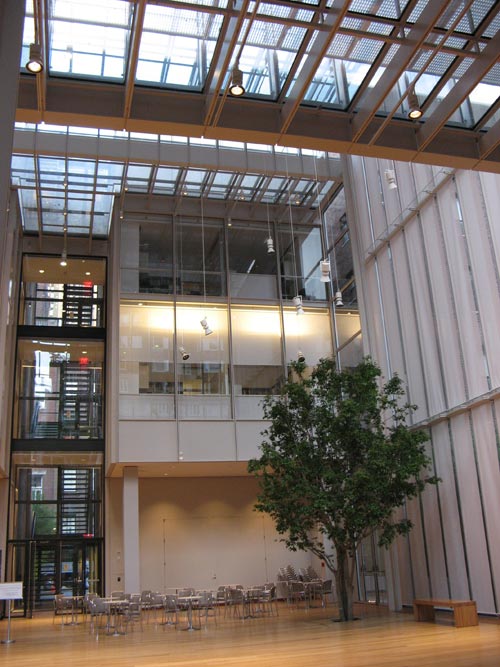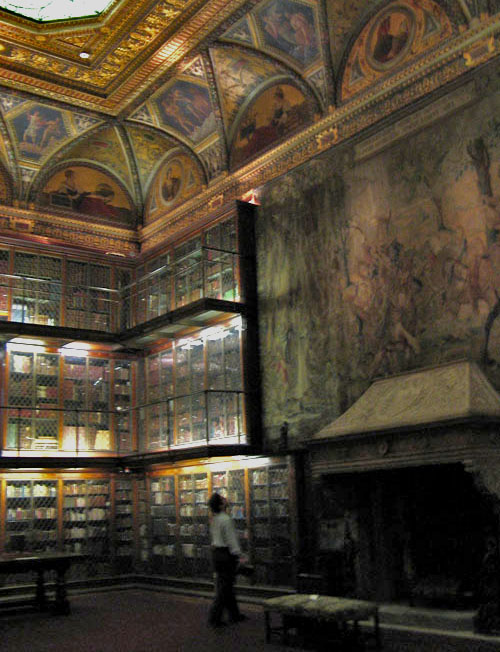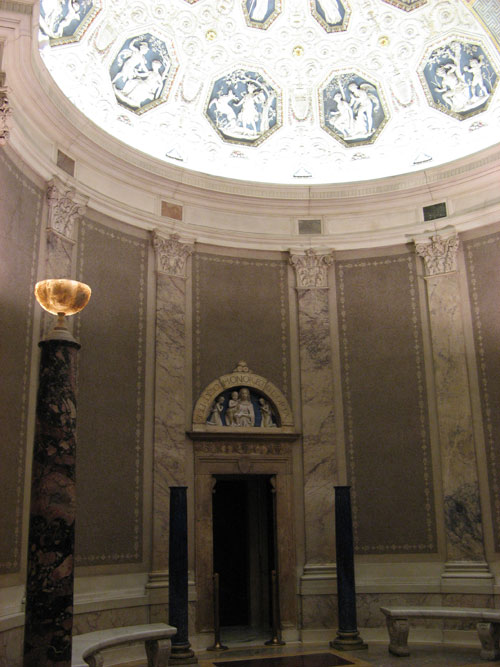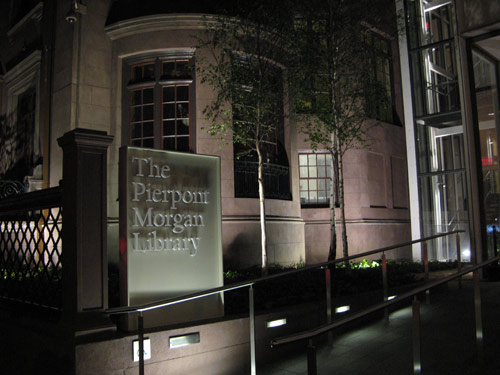Day: August 11th, 2006
The Morgan Library
The Morgan Library (now the Morgan Library and Museum ) reopened in late April 2006 after a three year renovation and expansion during which the exhibition spaces were doubled by the construction of Renzo Piano’s four-story, steel and glass atrium. We visited during Friday’s late evening hours, after a round of beers (Harp and Magic Hat #9, not Kiuchi Nest) at nearby Ginger Man.
Piano is the Pritzker-prize winning Italian architect, most famous for designing the Centre George Pompidou in Paris. The Morgan Library’s $100M addition is Piano’s first major work in New York City, but there are others planned in the years to come: the new headquarters building for The New York Times Company in Times Square, the Whitney Museum extension and a possible Northern extension of the Columbia University campus.
Renzo’s design links together the original 1906 library, the 1928 Annex, and the 1850s brownstone on Madison and 37th Street. The house was the home of J.P. (Jack) Morgan, Jr. until his death in 1943, after which it served as the headquarters of the Lutheran Church in America. The Morgan Library purchased it in 1988. Prior to the Morgan’s ownership, the house was home to wealthy philanthropists (and married cousins) Helen Phelps and Anson Stokes; their son, Isaac Newton Phelps-Stokes, was born in that house, and grew up to become a historian-author and architect of St. Paul’s Chapel on the Columbia University main campus. In 1966, the chapel was among the first buildings to be designated an official landmark by the New York City Landmarks Preservation Commission.
But back to the Morgan. A windowless cube gallery sits off to the South of the airy, new Gilbert Court (below) and serves as a showcase for Morgan’s considerable medieval art treasures, the most important of which is the mid-9th century gold and jeweled Lindau Gospel Book. The room also holds the mid-12th century copper gilt and enamel Stavelot Triptych.

It had been several years since I last set foot inside to view the objets d’art culled together by the senior John Pierpont Morgan, and I was impressed all over again with the breadth of his collection. A large portion was donated to The Metropolitan Museum of Art, of which Morgan was one-time president, but a select few remain here. The original Italian Renaissance-style Library building was built next to Morgan’s brownstone residence (since demolished) as a three-room showcase for his treasures at a personal cost of $1.2M. The East room, actually known as “Mr. Morgan’s Library,” is a majestic yet intimate space with a leaded skylight and vaulted ceiling murals by commissioned artist Henry Siddons Mowbray, head of the American Academy in Rome. The three tiers of dramatic floor-to-ceiling encased shelves are filled with some 5000 leather-bound volumes dating from the 16th to the 20th centuries.
No photos allowed: this one somehow made it into my camera while B stood in between me and the guard’s line of vision.

One highlight of the Library are the Gutenberg Bibles — one was on display in this room. The Morgan collection includes three of the ten copies in the United States — one vellum, and two paper, more copies than even the Vatican (which owns just two). Only sixty or so copies are known to still be in existence worldwide. The only other copy in New York City is owned by The New York Public Library. Yale, Harvard and Princeton Universities each own one copy, as does Bill Gates.
Below, the Rotunda, which sits between Mr. Morgan’s Library and Mr. Morgan’s Study — which with its red damask silk-covered walls and imported 16th century carved wood ceilings was once called the “most beautiful room in America.”

So much to see: drawings by da Vinci, Raphael, Michelangelo, Rubens, Dürer, Rembrandt, Degas and Picasso. Upstairs, an astonishing collection of literary and musical manuscripts: the only existing transcription of Milton’s Paradise Lost, Thoreau’s 40-volume journal, personal correspondence by Benjamin Franklin, crazily cramped early writings by all four Brontë siblings, Austen’s first unpublished novel, and works by Steinbeck, Balzac, Dickens, Poe, Burns, Byron, Keats, Shelley… sheets of music by Bach, Beethoven, Mozart, Chopin, Brahms, Schubert, Schumann, Mahler, Wagner…

It’s almost too much to take in during one visit. I, for one, am thrilled to have my — okay, our — Pierpont Morgan Library (and Museum) back.
Search
Popular Tags
Categories
Archive
- July 2010
- July 2009
- January 2009
- November 2008
- September 2008
- August 2008
- July 2008
- June 2008
- May 2008
- April 2008
- March 2008
- February 2008
- January 2008
- December 2007
- November 2007
- October 2007
- September 2007
- August 2007
- July 2007
- June 2007
- May 2007
- April 2007
- March 2007
- February 2007
- January 2007
- December 2006
- November 2006
- October 2006
- September 2006
- August 2006
- July 2006
- June 2006